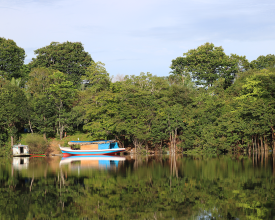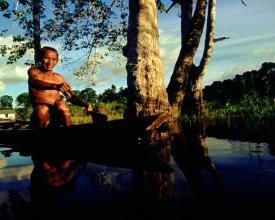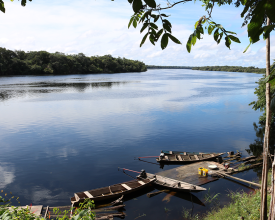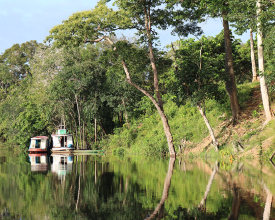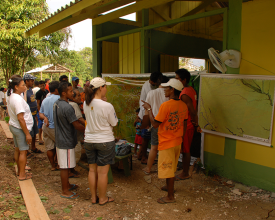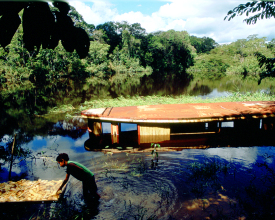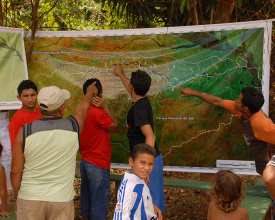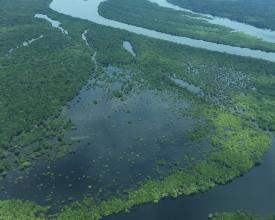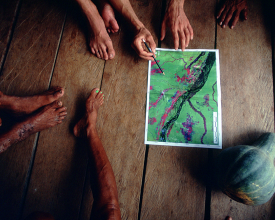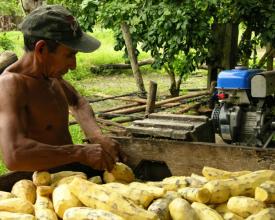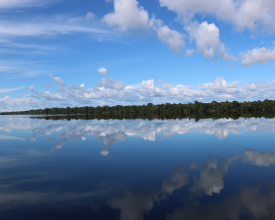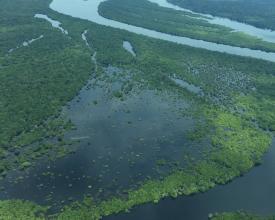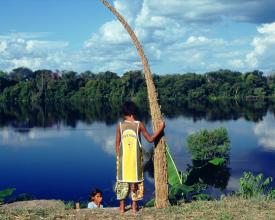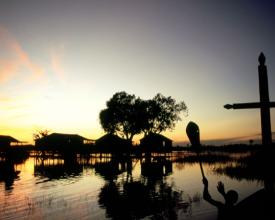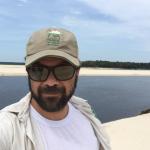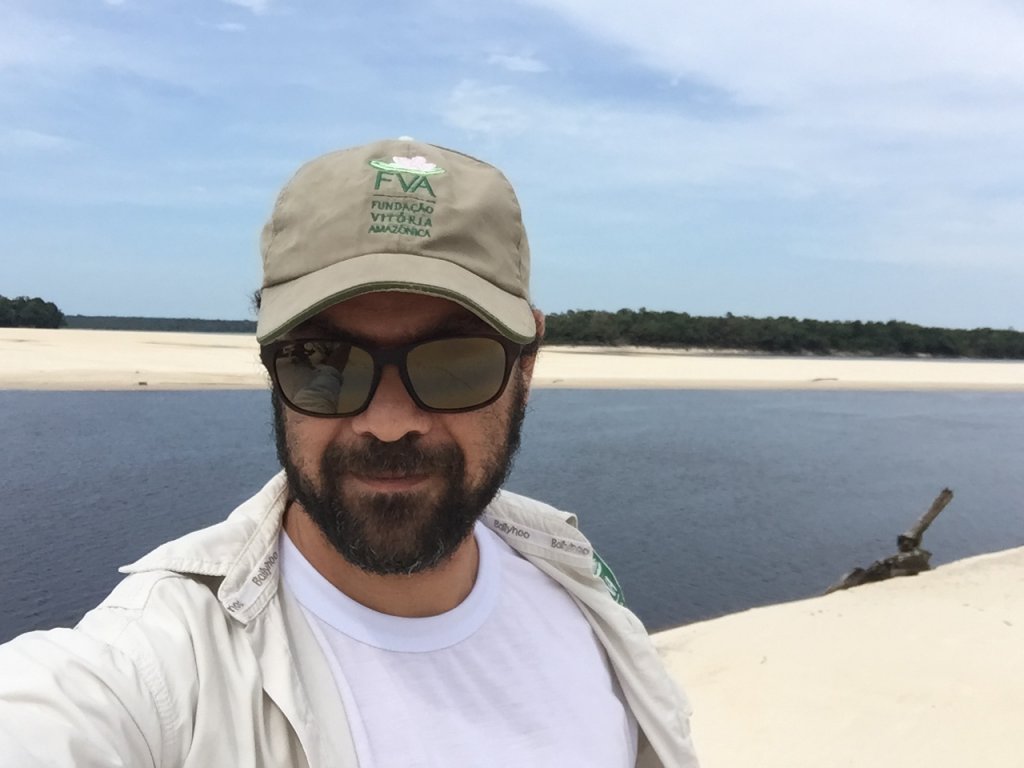
Trois facteurs de succès pour la conservation du bassin du Rio Negro en Amazonie brésilienne : Gouvernance et participation, alliances public-privé et mosaïques de conservation
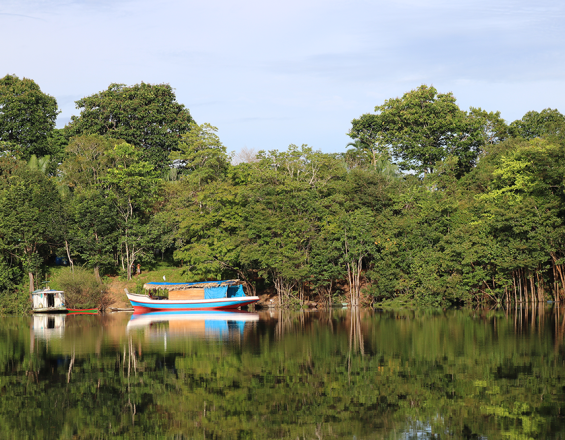
Cette solution favorise la participation locale, afin de garantir l'accès aux ressources naturelles dans la zone adjacente au parc national Jaú. Cette solution, associée à l'application d'une approche de conservation en mosaïque, pour consolider un territoire protégé plus étendu, et l'inclusion du parc dans un programme d'État pour la conservation des forêts tropicales, avec un financement public, privé et international, ont été des facteurs clés pour la conservation du bassin de la rivière Noire de l'Amazone.
Contexte
Défis à relever
Le parc national Jaú a été confronté à de forts conflits socio-environnementaux en raison de sa création en tant que catégorie de gestion d'une zone de protection stricte dans un territoire où les communautés locales et afro-descendantes sont historiquement présentes. Historiquement, le Jaú et l'Unini ont été deux des rivières les plus productives du Río Negro. Tous deux étaient des sources de production alimentaire autonomes, mais depuis la première occupation jésuite à Río Negro, les activités de pêche, d'agriculture à petite échelle et d'extraction des ressources forestières ont augmenté. En outre, la catégorie de protection stricte de ce parc national ne lui permet pas d'accueillir une population humaine, et le gouvernement a procédé à des expropriations de personnes vivant à Jaú, limitant ainsi les droits d'utilisation de ses ressources.
Emplacement
Traiter
Résumé du processus
Après la promulgation du système national de conservation Unitis, et avec le soutien technique et financier d'organisations locales telles que la Fondation Vitória Amazônica (FVA) et le Programme des zones protégées de la région amazonienne (ARPA), le RESEX du fleuve Unini a été créé à la demande des communautés locales. À cette fin, la FVA a créé un espace d'échange de connaissances entre d'autres réserves d'extraction et les communautés du fleuve Unini, en soutenant la création de l'Association des résidents du fleuve Unini (AMORU). Celle-ci, à son tour, après un processus de consultation publique, a formulé la demande officielle de création du RESEX de la rivière Unini. Le soutien du FVA a également contribué au renforcement des capacités organisationnelles et locales en vue d'une utilisation durable des ressources naturelles et du développement local. En conséquence, la gouvernance et la participation des acteurs locaux aux processus décisionnels au sein des unités de conservation s'améliorent, ce qui constitue la base d'une gestion efficace des zones protégées et de la mise en œuvre d'une approche de conservation en mosaïque qui les intègre en tant qu'unités au sein d'un territoire plus vaste.
Blocs de construction
Participation locale pour garantir l'accès aux ressources naturelles et la possession de terres
En 1979, la zone actuellement occupée par le parc national de Jaú a été proposée comme réserve biologique, une catégorie de gestion qui restreint l'exploitation des ressources naturelles au Brésil. En 1980, le parc national Jaú a été créé et, depuis lors, il doit relever le défi de gérer le niveau élevé de conflit socio-environnemental dans la région.
La Fondation Vitória Amazônica (FVA), présente dans la région depuis 1991, a appliqué des méthodologies de cartographie innovantes et participatives pour l'utilisation des ressources naturelles, qui ont servi de base au développement de son plan de zonage et de gestion, entre 1996 et 1998, dans le cadre d'un contrat de cogestion avec le gouvernement fédéral du Brésil. Quelques années plus tard, le Brésil a créé le Système national d'unités de conservation (SNUC) et a développé des outils pour mettre en place des processus participatifs. En conséquence, le FVA, en tant qu'institution technique collaboratrice de l'Institut brésilien de l'environnement et des ressources naturelles renouvelables (IBAMA), a apporté son soutien aux communautés locales lors de la création de la réserve d'extraction de la rivière Unini (RESEX), dans un processus qui a duré jusqu'en 2006, avec l'intention de garantir l'accès aux ressources naturelles et à la propriété foncière pour les populations des rivières Jaú et Unini.
Facteurs favorables
- Création du système national d'unités de conservation (SNUC).
- Promotion de la participation sociale dans la gestion des unités de conservation (UC).
- Développement d'outils pour la gestion des conflits socio-environnementaux.
- Appui technique et financier aux processus de formation entre les gestionnaires des aires protégées et les représentants locaux.
- Création de l'Association des résidents de la rivière Unini (AMORU) pour la création du RESEX de la rivière Unini.
Leçon apprise
La création du RESEX de la rivière Unini a nécessité un processus participatif qui a permis de négocier et de définir avec les communautés locales un ensemble de conditions favorables pour permettre la conception et l'application de mécanismes de consultation, le zonage de l'utilisation des ressources naturelles et la création d'organismes participatifs tels que le Conseil délibératif du RESEX, en 2008.
La première étape a été la création de l'AMORU qui, à son tour, a fait la demande officielle de création du RESEX. Ensuite, un processus de consultation publique a été mis en place dans les communautés locales, afin de soutenir la création de la réserve. Une fois la réserve créée, l'Institut Chico Méndez pour la conservation de la biodiversité (ICMBio), une institution liée au ministère de l'environnement, et la FVA ont entamé les processus de gestion. Parmi ceux-ci, la formation du Conseil délibératif, composé de représentants d'agences gouvernementales, d'organisations de la société civile et de la population locale représentative de la zone.
Ressources
Gouvernance et participation des acteurs locaux à la gestion et à l'utilisation des ressources naturelles
Dans le cadre du processus de création de la réserve d'extraction de la rivière Unini (RESEX) et du contrat de cogestion du parc national Jaú, la FVA a mis en œuvre des méthodologies de cartographie innovantes et participatives pour l'utilisation des ressources naturelles et a investi dans un processus de renforcement des capacités organisationnelles et locales pour l'utilisation durable des ressources naturelles. Parmi ces projets, on peut citer le développement et la mise en œuvre d'une méthodologie pour l'utilisation des ressources naturelles (SIMUR) dans la rivière Unini. Cette méthodologie a servi de base à un processus en 2008, après la création du RESEX, avec le développement et la mise en œuvre de "Termes d'engagement" avec les communautés locales de la rivière Unini. Ces documents représentent une série d'accords entre les six communautés vivant le long de la rivière Unini dans le parc national Jaú et le gouvernement brésilien. L'objectif de ces accords était de réglementer leur permanence dans le parc et d'établir un processus de cogestion avec la population locale et l'administration du parc. Par conséquent, la participation des communautés aux processus de prise de décision dans les deux unités de conservation (le parc national Jaú et le RESEX de la rivière Unini) était et reste fondamentale pour la gestion efficace des deux zones.
Facteurs favorables
- Développement d'outils axés sur la gestion des conflits socio-environnementaux.
- Promotion de la participation sociale dans la gestion des unités de conservation.
- Zonage de l'utilisation et de l'exploitation de la zone protégée établi avec trois catégories distinctes et mis en œuvre sur le territoire grâce à un processus participatif solide.
- Création de la Coopérative agricole mixte d'extraction de la rivière Unini (COOMARU) pour l'utilisation des ressources naturelles.
Leçon apprise
Différents processus de planification pour la gestion des deux unités de conservation ont permis d'avancer dans le renforcement des capacités organisationnelles et locales pour le développement d'activités économiques. Par exemple, le COOMARU a été créé, dédié au commerce équitable des noix brésiliennes et au développement d'une infrastructure de base pour le stockage et le bénéfice des producteurs agricoles extractifs. En outre, les résidents locaux sont la principale source d'information sur l'utilisation des ressources naturelles. Par conséquent, les programmes et les projets qui encouragent la participation de la communauté à la collecte, à la systématisation, au stockage et à l'analyse des données ont le potentiel de transformer le processus de gestion des unités de conservation, car ils organisent et classent les informations sur les activités de production et de subsistance à l'intérieur et autour de ces zones. De cette façon, la dynamique de formation des moniteurs communautaires et des résidents contribue à former des leaders communautaires chargés de la gestion des zones protégées.
Ressources
ARPA : le plus important programme de conservation des forêts tropicales humides du Brésil et les mécanismes de viabilité financière du parc national Jaú
Le parc national Jaú représente l'une des plus grandes extensions de forêts tropicales humides protégées au monde, protégeant une grande partie du bassin de la rivière Aguas Negras. En raison de son importance, cette zone protégée a été désignée comme prioritaire par le programme des zones protégées de la région amazonienne (ARPA), un programme créé en 2002 par le gouvernement brésilien et géré par le Fonds brésilien pour la biodiversité (Funbio).
Le programme ARPA bénéficie du soutien financier du Fonds pour l'environnement mondial (FEM), du gouvernement allemand, du Fonds mondial pour la nature (WWF), du Fonds pour l'Amazonie, par l'intermédiaire de la Banque nationale pour le développement économique et social (BNDES), de la Fondation Moore et, actuellement, d'entreprises privées qui agissent en tant que donateurs du programme. Le programme est conçu pour durer 13 ans et vise à étendre et à renforcer le système national brésilien de zones protégées en Amazonie, en protégeant 60 millions d'hectares d'unités de conservation dans le biome amazonien et en garantissant des ressources financières pour la gestion de ces zones à court et à long terme. Il est mis en œuvre en trois phases indépendantes et continues : La phase I entre 2003 et 2010, la phase II entre 2010 et 2015, et la phase III avec un délai de 25 ans.
Facteurs favorables
- Contexte national de plus grande préoccupation pour la préservation de la région amazonienne et le développement durable, avec la reconnaissance mondiale de l'importance des forêts tropicales humides.
- Élaboration de politiques publiques régionales pour la conservation et l'utilisation durable des forêts tropicales humides.
- Budget du programme ARPA pour 2003-2015, de 236 millions de dollars.
Leçon apprise
L'inclusion du parc national Jaú dans le programme ARPA était une stratégie essentielle pour sa conservation, étant donné que l'ARPA est l'un des plus grands programmes au monde pour la conservation des forêts tropicales humides, mettant en œuvre un modèle qui garantit la collecte et l'application rapides et efficaces des ressources financières.
Au cours de la phase I, l'ARPA s'est consacré à la création de nouvelles zones protégées. Au cours de la phase II, il s'est concentré sur la consolidation du programme. La phase III vise à consolider 60 millions d'hectares de zones protégées en Amazonie aux niveaux fédéral et national, et à atteindre la viabilité financière.
Le soutien apporté par l'ARPA a permis la création du RESEX de la rivière Unini, la consolidation du RESEX et du parc national Jaú grâce au financement de projets qui ont permis de générer une valeur de conservation et d'augmenter les revenus financiers des communautés locales. Cela contribue à la durabilité des deux unités de conservation au niveau social, financier et de la gestion.
Mosaïques de conservation : une stratégie efficace pour consolider les grandes étendues de territoires protégés au Brésil
La loi sur le système national des zones protégées, promulguée en juillet 2000, a établi l'approche de la mosaïque de conservation. Les mosaïques sont un "ensemble d'unités de conservation (UC) de catégorie égale ou différente qui sont proches, adjacentes ou se chevauchent, ainsi que d'autres zones protégées publiques ou privées" qui sont gérées de manière intégrée, conformément aux objectifs de chaque UC.
Pour relever le défi de la gestion des conflits socio-environnementaux et de l'optimisation des ressources humaines, financières et matérielles, la Mosaïque de conservation du Bajo Río Negro a été créée en 2010, avec une superficie totale de 7 329 220 hectares, et intégrée par 11 UC, dont le Parc national Jaú et le RESEX Unini. La mise en œuvre de cette approche donne la priorité aux processus de conservation de zones plus vastes, ce qui permet une gestion intégrée du paysage des zones situées le long des rivières Jaú et Unini au nord, et du Bajo Río Negro au sud de la mosaïque. En considérant les zones protégées comme des parties d'une unité plus grande, fonctionnelle et interconnectée, il a été nécessaire d'inclure une méthodologie participative dans la conception des plans de gestion, qui encourage la participation de multiples acteurs dans le processus de prise de décision lié à l'administration du territoire et de ses ressources naturelles.
Facteurs favorables
- L'approche de gestion de la mosaïque de conservation permet l'intégration de multiples acteurs et opportunités d'assistance technique et financière pour la gestion territoriale.
- Liaison des efforts dans les zones ayant une identité territoriale partagée, pour atteindre un objectif commun de conservation et de gestion durable des ressources naturelles.
- Institutionnalisation d'un conseil consultatif en tant que force mobilisatrice dans la région.
- Planification stratégique à l'échelle du paysage.
Leçon apprise
Les éléments clés de la gestion intégrée du paysage comprennent la mise en œuvre d'un plan d'action pour la mosaïque, la création d'un conseil consultatif pour soutenir la prise de décision, le développement de méthodologies participatives pour le zonage des zones d'utilisation communautaire et de subsistance, et le renforcement des capacités locales par le biais de processus de formation pour la gestion des ressources naturelles, l'agriculture durable, le tourisme, et les droits et obligations des communautés locales.
Les avantages de la gestion intégrée sont les suivants : optimisation des ressources ; planification intégrée du paysage ; coordination des activités de protection ; éducation, surveillance et sensibilisation à l'environnement dans la région ; possibilité de développer une identité territoriale intégrée basée sur les caractéristiques de la région ; développement de stratégies unifiées pour la valorisation des produits pour les communautés autour et à l'intérieur des unités de conservation ; et facilitation des accords et de la résolution des conflits.
Impacts
- La création de la réserve d'extraction de la rivière Unini à la suite d'un processus de consultation publique, avec la participation des communautés locales.
- La création d'une méthodologie innovante de cartographie et de zonage de l'utilisation qui a permis de travailler avec des personnes ayant des niveaux d'analphabétisme différents.
- Le renforcement des organisations et des capacités locales pour permettre aux communautés locales de développer des activités productives alternatives.
- Les projets de développement local et de gestion des ressources naturelles dans les communautés contribuent à une meilleure compréhension des stratégies de gestion des zones protégées, ce qui a un impact positif sur la capacité de négociation des communautés locales.
- La consolidation du parc national Jaú et de la réserve d'extraction de la rivière Unini en tant que moteurs participatifs dans la conception des plans de gestion et la planification de l'utilisation des terres.
- L'inclusion des deux zones protégées dans la mosaïque de conservation du bas Rio Negro.
- La gestion et la planification intégrées du paysage, qui permettent d'optimiser les ressources et de coordonner les activités de protection, l'éducation environnementale, la surveillance et les campagnes de sensibilisation dans la région.
- Le travail dans le cadre d'une identité territoriale consolidée, basée sur les caractéristiques de la région, qui a permis d'intégrer de multiples facteurs et de générer de meilleures opportunités de soutien technique et financier pour la gestion territoriale.
Bénéficiaires
La rivière Unini compte dix communautés et environ 186 familles qui se consacrent à la pêche et à l'agriculture familiale. Trois de ces communautés sont situées à l'intérieur du RESEX, et six dans le parc national.
Objectifs de développement durable
Histoire
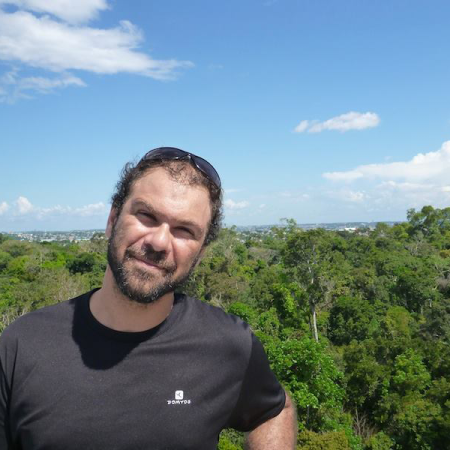
"La Fondation Vitória Amazônica (FVA) a commencé à travailler dans le parc national Jaú en 1991, dix ans après la création du parc. Au cours des premières années, nous avons développé un processus de recherche cartographique sur l'utilisation des ressources naturelles par les communautés locales et nous avons élaboré le plan de gestion du parc, dans le cadre d'un contrat de cogestion avec le gouvernement fédéral entre 1996 et 1998. Quelques années après avoir terminé le plan de gestion, nous avons entamé le processus de création de l'unité de conservation (la réserve d'extraction de la rivière Unini), un processus qui s'est poursuivi jusqu'en 2006 et qui a permis aux communautés vivant dans la rivière Unini de voir leurs droits garantis en matière d'accès à la terre et aux ressources naturelles.
Après la création de la RESEX du fleuve Unini, l'ICMBio a entamé les processus de gestion, c'est-à-dire l'élaboration du plan de gestion et la création du conseil délibératif de l'unité, avec le soutien de la FVA en tant qu'alliée technique de l'ICMBio et des communautés locales. Aujourd'hui, nous mettons en œuvre un système de surveillance des ressources naturelles qui répond à deux objectifs. D'une part, que les communautés locales connaissent leur propre dynamique d'utilisation des ressources naturelles afin qu'elles puissent atteindre un niveau plus élevé d'autonomie de gestion. L'autre est de fournir au gouvernement fédéral de meilleures connaissances sur l'utilisation des ressources pour la gestion du parc et la biodiversité. Par ailleurs, nous avons également lancé une série de projets au profit des communautés. Par exemple, la production de châtaignes, la gestion de la pêche ornementale, les produits agricoles et les services touristiques.
L'un des problèmes les plus importants auxquels nous avons été confrontés au cours des 15 dernières années a été le manque de personnel dans les zones protégées et sa rotation sporadique, ce qui entraîne l'arrêt des procédures existantes. Cela a été le cas principalement pour le parc Jaú, car le RESEX a été beaucoup plus stable. C'est dans ce domaine que la Fondation apporte sa contribution, en permettant à certains processus de fonctionner avec une plus grande indépendance vis-à-vis du gouvernement et de continuer à fonctionner grâce à notre coopération, de manière à maintenir le niveau de constance dans les processus complexes de recherche, d'organisation sociale et de développement économique. Parallèlement à cette coopération, nous réalisons des efforts de collecte de fonds qui permettent de maintenir un investissement constant dans les processus et l'articulation des communautés au sein de la zone protégée, ainsi que l'effort de recherche que nous développons avec les communautés".

